Chem 219 unit 2 - Study guides, Class notes & Summaries
Looking for the best study guides, study notes and summaries about Chem 219 unit 2? On this page you'll find 40 study documents about Chem 219 unit 2.
Page 2 out of 40 results
Sort by

-
Chem&219 Unit 2 NAMING Questions & answers
- Exam (elaborations) • 10 pages • 2024
- Available in package deal
-
- $7.99
- + learn more
Chem&219 Unit 2 NAMING Questions & answers
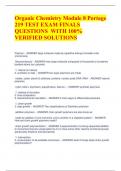
-
Organic Chemistry Module 8 Portage 219 TEST EXAM FINALS QUESTIONS WITH 100% VERIFIED SOLUTIONS
- Exam (elaborations) • 15 pages • 2024
- Available in package deal
-
- $14.09
- + learn more
Organic Chemistry Module 8 Portage 219 TEST EXAM FINALS QUESTIONS WITH 100% VERIFIED SOLUTIONS Polymer - ANSWER large molecule made by repetitive linking of smaller units (monomers) Macromolecule - ANSWER very large molecule composed of thousands of covalently bonded atoms (ex: polymer) 1. natural (in nature) 2. synthetic (in lab) - ANSWER two ways polymers are made rubber, carbs: starch & cellulose, proteins, nucleic acids DNA, RNA - ANSWER natural polymers nylon, teflon, sty...
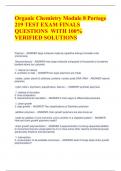
-
Organic Chemistry Module 8 Portage 219 TEST EXAM FINALS QUESTIONS WITH 100% VERIFIED SOLUTIONS
- Exam (elaborations) • 15 pages • 2024
-
- $12.99
- + learn more
Organic Chemistry Module 8 Portage 219 TEST EXAM FINALS QUESTIONS WITH 100% VERIFIED SOLUTIONS Polymer - ANSWER large molecule made by repetitive linking of smaller units (monomers) Macromolecule - ANSWER very large molecule composed of thousands of covalently bonded atoms (ex: polymer) 1. natural (in nature) 2. synthetic (in lab) - ANSWER two ways polymers are made rubber, carbs: starch & cellulose, proteins, nucleic acids DNA, RNA - ANSWER natural polymers nylon, teflon, sty...
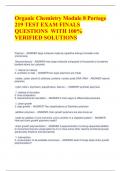
-
Organic Chemistry Module 8 Portage 219 TEST EXAM FINALS QUESTIONS WITH 100% VERIFIED SOLUTIONS
- Exam (elaborations) • 15 pages • 2024
-
- $14.49
- + learn more
Organic Chemistry Module 8 Portage 219 TEST EXAM FINALS QUESTIONS WITH 100% VERIFIED SOLUTIONS Polymer - ANSWER large molecule made by repetitive linking of smaller units (monomers) Macromolecule - ANSWER very large molecule composed of thousands of covalently bonded atoms (ex: polymer) 1. natural (in nature) 2. synthetic (in lab) - ANSWER two ways polymers are made rubber, carbs: starch & cellulose, proteins, nucleic acids DNA, RNA - ANSWER natural polymers nylon, teflon, sty...
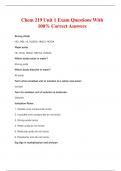
-
Chem 219 Unit 1 Exam Questions With 100% Correct Answers
- Exam (elaborations) • 2 pages • 2024
- Available in package deal
-
- $10.49
- + learn more
Chem 219 Unit 1 Exam Questions With 100% Correct Answers Strong Acids HCl, HBr, HI, H2SO4, HNO3, HClO4 Weak acids HF, HCN, HNO2, H3PO4, H2SO3 Which acids ionize in water? Strong acids Which acids dissolve in water? All acids Term when smallest unit of solution is a cation and anion: Ionized Tern for smallest unit of solution is molecule: Dissolve Ionization Rules 1. Soluble ionic compounds ionize 2. Insoluble ionic compounds do not ionize

-
Organic Chemistry Module 8 Portage 219 100% VERIFIED SOLUTIONS
- Exam (elaborations) • 15 pages • 2023
-
- $10.99
- + learn more
Organic Chemistry Module 8 Portage 219 100% VERIFIED SOLUTIONS Polymer - ANSWER large molecule made by repetitive linking of smaller units (monomers) Macromolecule - ANSWER very large molecule composed of thousands of covalently bonded atoms (ex: polymer) 1. natural (in nature) 2. synthetic (in lab) - ANSWER two ways polymers are made rubber, carbs: starch & cellulose, proteins, nucleic acids DNA, RNA - ANSWER natural polymers nylon, teflon, styrofoam, polyethylene, Dacron, - AN...
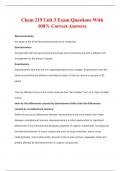
-
Chem 219 Unit 3 Exam Questions With 100% Correct Answers
- Exam (elaborations) • 13 pages • 2024
- Available in package deal
-
- $12.49
- + learn more
Chem 219 Unit 3 Exam Questions With 100% Correct Answers Stereochemistry the study of the three-dimensional structure of molecules Stereoisomers Compounds with the same structural formula and connectivity but with a different 3D arrangement of the atoms in space. Enantiomers Stereoisomers that that are non-superimposable mirror images. Enantiomers have the same connectivity but different orientations (twist) of the four atoms or groups in 3D space. The two different forms of the chira...
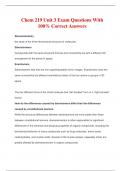
-
Chem 219 Unit 3 Exam Questions With 100% Correct Answers
- Exam (elaborations) • 13 pages • 2024
- Available in package deal
-
- $12.49
- + learn more
Chem 219 Unit 3 Exam Questions With 100% Correct Answers Stereochemistry the study of the three-dimensional structure of molecules Stereoisomers Compounds with the same structural formula and connectivity but with a different 3D arrangement of the atoms in space. Enantiomers Stereoisomers that that are non-superimposable mirror images. Enantiomers have the same connectivity but different orientations (twist) of the four atoms or groups in 3D space. The two different forms of the chira...
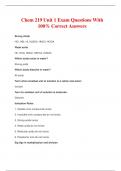
-
Chem 219 Unit 1 Exam Questions With 100% Correct Answers
- Exam (elaborations) • 2 pages • 2024
- Available in package deal
-
- $10.49
- + learn more
Chem 219 Unit 1 Exam Questions With 100% Correct Answers Strong Acids HCl, HBr, HI, H2SO4, HNO3, HClO4 Weak acids HF, HCN, HNO2, H3PO4, H2SO3 Which acids ionize in water? Strong acids Which acids dissolve in water? All acids Term when smallest unit of solution is a cation and anion: Ionized Tern for smallest unit of solution is molecule: Dissolve Ionization Rules 1. Soluble ionic compounds ionize 2. Insoluble ionic compounds do not ionize 3. Strong acids ionize 4. Weak acids do...

-
Chem 219 Unit 4 Exam Questions With 100% Correct Answers
- Exam (elaborations) • 15 pages • 2024
- Available in package deal
-
- $12.49
- + learn more
Chem 219 Unit 4 Exam Questions With 100% Correct Answers What are the four halogen elements? - answerF, Cl, Br, I organohalide compounds - answerOrganic molecules containing halogen atoms (F, Cl, Br, I) Examples of how organohalide compounds are used by humans - answer- have been found in marine life (algae, mollusks, sponges, etc.), bc they metabolize the high concentrations of inorganic chlorides and bromides that are found in the seas. - Industrially, organohalides find uses as solvent...

That summary you just bought made someone very happy. Also get paid weekly? Sell your study resources on Stuvia! Discover all about earning on Stuvia


